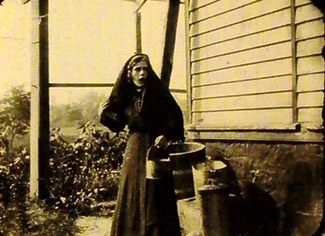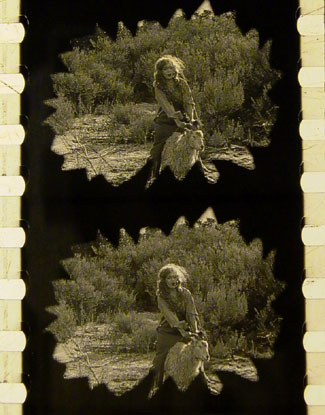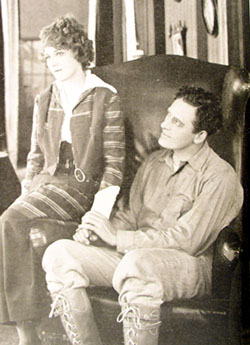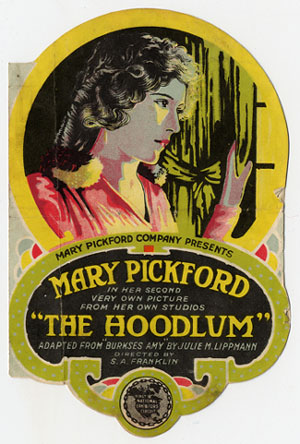George Eastman House Project Report
The project to locate and catalog extant Mary Pickford film material began in July 1997 at the George Eastman House (GEH) in Rochester, New York. The museum's motion picture archive has the second largest collection of Pickford titles in the United States and only the Cinèmathèque Français in Paris and a private collection held by the Mary Pickford Foundation has more 35mm material.
The quality and quantity of GEH's Pickford titles is due in large part to the late James Card, former curator of the museum's motion picture department. Card was a huge fan of silent film and particularly fond of its actresses. Pickford was one of his favorites and he worked from the beginning of his career at GEH to acquire as many of her films as possible. He began by cultivating a personal and professional relationship with Pickford, whom he met at the opening of GEH on November 9, 1949.
Card knew the Library of Congress (LC) had acquired the actress's sizeable film collection in late 1946, but that it had been unable to preserve the majority of it due to a loss in government funding. In late 1951, he convinced Pickford to allow GEH access to her film collection for the purpose of copying it on safety stock. It was an arrangement that benefitted everyone, including the LC who requested 16mm prints be made for its own collection. Unfortunately, GEH had only enough funds to copy a handful of Pickford titles, leaving numerous shorts and features unpreserved. But Card was not deterred.
With the help of museum director Oscar Solbert, Card secured a $10,000 donation from Pickford to preserve the remaining titles in her collection. Card, now curator of GEH's motion picture department, had the funds transferred to the LC and the U.S.D.A film lab began the work in the summer of 1956. GEH and the LC received 16mm prints of numerous features and about a dozen shorts in Pickford's possession. Most were copied from 35mm nitrate negatives, but when only a nitrate print was available, 35mm safety negatives were made. The 35mm material was given to the LC, and then 16mm prints were made for both archives.

"'Tween Two Loves"
(1911), one of a dozen 16mm Pickford shorts gifted to GEH in 1957.
35mm tinted nitrate positive (AFI/Cohen Collection, 1978)
[1]
GEH received the Pickford Collection 16mm prints in the spring of 1957. A number of those titles, including "The Foundling" (1916), "Johanna Enlists" (1918), "The Pride of the Clan" (1917), "Rags" (1915), and the silent version of "Taming of the Shrew" (1929), are unique to the GEH and LC collections. The museum also acquired the best surviving material of the original 1917 release version of "The Little American," "A Little Princess," (1917) and "Through the Back Door" (1922) when it copied Pickford Collection material in 1952.[2] During my research, these titles and the majority of the Pickford Collection were in good to fair condition. Two titles, "Amarilly of Clothes-Line Alley" and "Stella Maris" had been replaced, due to a theft of GEH's prints on loan to MoMA in the 1960s.

Nitrate frames from the
early Pickford feature "Rags."
35mm tinted nitrate positive (Pickford Collection, 1995)
[3]
Card pursued Pickford titles from additional sources during the 1960s and 1970s. He acquired a number of Pickford nitrate features from movie studios and private collectors, including "Daddy-Long-Legs" (1919), "The Hoodlum" (1919), and two rare titles, "Behind the Scenes" (1914) and "A Romance of the Redwoods" (1917). The archive also has the best material of the 1909 Biograph short "The Light That Came," a rare IMP title "The Mirror" (1911), and a Technicolor screen test of the actress shot in 1925. GEH continues to pursue Pickford material and in 2000 received copies of two early Pickford features, "The Eagle's Mate" (1914) and "Fanchon the Cricket" (1915), from the British Film Institute.

Mary Pickford and James
Kirkwood in "Behind the Scenes" (1914).
Locating and cataloguing Pickford film material in the GEH collection was a relatively easy task. Aided by reference sources like Ron Magliozzi's Treasures from the Film Archives and the FIAF database, I was able to find titles in the archive's growing computer database, bound notebooks and note cards. The archive's records were made complete and accurate with a just few updates. Several nitrate shorts, including "Friends" (1912), "Artful Kate" (1911) and "1776; or The Hessian Renegades" (1909) were missing. One title, "The Mirror," had never been accessioned by GEH until I 'rediscovered' it in 1997 during a routine assignment as a student of the archive's preservation school.
After finishing my Pickford research at GEH, I recommended a number of rare or unique titles for preservation. A few of those titles, including "Behind the Scenes," "The Hoodlum," and "The Technicolor Test of Mary Pickford from the Black Pirate" have been restored and are available for screening.[4] Two titles available only on nitrate, "The Light that Came" (1909) and "Heart o' the Hills" (1919), have not been preserved as of early 2003.

Promotional flier for "The
Hoodlum."
(Author's Collection)
"The Light that Came" is a Pickford Biograph that is known to survive only in the Paper Print Collection at the LC. GEH's rare early-generation copy was in fair condition in 1997 and my project designates it as a preservation priority. The foreign camera negative of "Heart o' the Hills," which Warner Brothers had donated to the museum in the 1970s, was never copied and had reached the early to middle stages of decomposition when I examined it. Other material is known to survive, including 16mm prints at GEH and the LC, and 35mm safety material at the Cinematheque in Paris and the Pickford Library's private collection. All of this material was copied from Pickford Collection material in the 1950s and 1960s. GEH's unique copy could aid in a proper restoration of the title.
Correspondence, memos, and official papers that document the relationship between Pickford and GEH's motion picture department, and the relationship between the LC and GEH regarding the Pickford Collection were unavailable to me during my research at the museum. In 1997, when I studying the GEH material, there was confusion as to whether the paper material had been lost or destroyed. Subsequent requests for information have turned up nothing. Luckily, paper documents, including correspondence between Pickford and GEH staff James Card and George Pratt, can be found in the Pickford Collection at the Academy of Motion Picture Arts and Sciences (AMPAS) in Los Angeles, CA. The relationship between GEH and the LC can be found in documents in the Manuscript Division and the Motion Picture Reading Room at the Library of Congress.
NOTES
[1] Frame enlargement courtesy of the Library
of Congress Motion Picture Conservation Center.
[2] The UCLA Film and Television Archive has a 1925 reissue print of "The
Little American" that is 500 ft. longer than GEH's material, but is missing
intertitles found in the 1917 release version. GEH also has the alternative
ending found in the outtakes.
[3] Frame enlargement courtesy of the Library of Congress
Motion Picture Conservation Center. Used by permission of The Mary Pickford
Foundation.
[4] "The Hoodlum" was a joint restoration involving material from
the GEH and the Mary Pickford Library. AMPAS paid for the work and copies were given to all parties.